The Mogadishu Line is the point at which foreign involvement in a conflict shifts from peacekeeping or diplomacy to combat operations. [1] The term often comes about in reference to the reluctance of international actors to intervene militarily in another state for humanitarian reasons. This reluctance comes about from fears that meaningful political changes may not be achievable without military actions, but that the military actions would be at odds with the diplomatic or humanitarian purposes and may become a bloody debacle. [2]
The term was a reference to the external intervention in the Somali Civil War in which several opposing factions engaged in a struggle to seize control of Somalia. In April 1992, calls for action by UN Secretary-General Boutros Boutros-Ghali prompted the UN Security Council to approve the commencement of humanitarian operations into Somalia, which initially involved a small contingent of UN-approved troops (UNOSOM), followed in December by a US-dominated military force UNITAF. However, these humanitarian and nation-building efforts were stymied by the nation's various clans refusing to share power and the violent clashes which ensued.
In March 1993, the UN Security Council authorized a new mission, UNOSOM II, which was endowed with enforcement powers under Chapter VII of the UN Charter to establish a secure environment throughout Somalia. However, operations turned sour after the Battle of Mogadishu on October 3, 1993, when US forces attempted to launch an attack on the Olympic Hotel in search of Mohamed Farrah Aidid. [3] The subsequent combat resulted in the deaths of 18 US soldiers and a further 83 casualties. After the battle, the bodies of several US casualties of the conflict were dragged through the streets of Mogadishu by crowds of local civilians and members of Aidid's Somali National Alliance.
After the disastrous battle, pressure immediately built for a withdrawal of US troops. US President Bill Clinton said in a few days later that "our mission from this day forward is to increase our strength, do our job, bring our soldiers out and bring them home." He announced that troops would be withdrawn by mid-1994. [4]
The concept of the Mogadishu Line became ingrained in international relations discourse after the Cold War. Fear of a repeat of the events in Somalia shaped US policy in subsequent years, with many commentators identifying the graphic consequences of the Battle of Mogadishu as the key reason behind the US failure to intervene in later conflicts such as the 1994 Rwandan Genocide. [5] According to the former US deputy special envoy to Somalia, Walter Clarke, "The ghosts of Somalia continue to haunt US policy. Our lack of response in Rwanda was a fear of getting involved in something like a Somalia all over again." [4]
Clinton also refused to mobilize US ground troops in fighting the Bosnian Serb Army in Bosnia and Herzegovina in 1995 and the Yugoslav Army in the Federal Republic of Yugoslavia (specifically, the province of Kosovo) in 1999.
In the 1990s, General Michael Rose, the head of the United Nations Protection Force, insisted that the United Nations would never "cross the Mogadishu Line." [1] However, his replacement, Rupert Smith, came to the conclusion that the Protection Force's humanitarian mandate was insufficient.
In 2003, Keane stated that changes in US policy toward Liberia suggested that the Mogadishu Line had been "erased." [5]
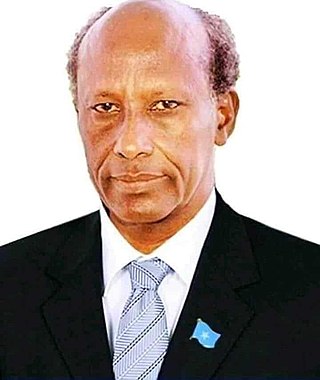
Mohamed Farrah Hasan Garad, popularly known as General Aidid or Aideed, was a Somali military officer and warlord.
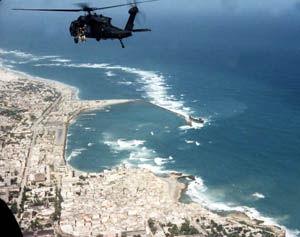
The Battle of Mogadishu, also known as the Black Hawk Down Incident, was part of Operation Gothic Serpent. It was fought on 3–4 October 1993, in Mogadishu, Somalia, between forces of the United States—supported by UNOSOM II—against the forces of the Somali National Alliance (SNA) and armed irregulars of south Mogadishu.

April Catherine Glaspie is an American former diplomat and senior member of the Foreign Service, best known for her role in the events leading up to the Gulf War.
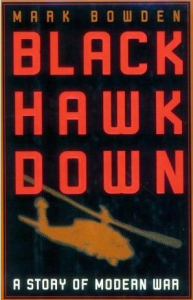
Black Hawk Down: A Story of Modern War is a 1999 book by journalist Mark Bowden. It documents efforts by the Unified Task Force to capture Somali faction leader Mohamed Farrah Aidid in 1993, and the resulting battle in Mogadishu between United States forces and Aidid's militia. One of the key events is the downing of two United States MH-60 Black Hawk helicopters, from which the book derives its title, and the attempt to rescue their crews. United States forces included 3rd Battalion, 75th Ranger Regiment; 160th SOAR; Delta Force; 24th Special Tactics Squadron; DEVGRU Navy SEALs; 10th Mountain Division; as well as Malaysian and Pakistani United Nations peacekeeping forces.

Operation Gothic Serpent was a military operation conducted in Mogadishu, Somalia, by an American force code-named Task Force Ranger during the Somali Civil War in 1993. The primary objective of the operation was to capture Mohamed Farrah Aidid, leader of the Somali National Alliance who was wanted by the UNOSOM II in response to his attacks against United Nations troops. The operation took place from August to October 1993 and was led by US Joint Special Operations Command (JSOC).

The United Nations Operation in Somalia II was the second phase of the United Nations intervention in Somalia and took place from March 1993 until March 1995, following the outbreak of the Somali Civil War in 1991. UNOSOM II carried on from the transitory United States-controlled (UN-sanctioned) Unified Task Force (UNITAF), which had been preceded by UNOSOM I. Notably, UNOSOM II embarked on a nation-building mission, diverging from its predecessors. As delineated in UNSCR 814, the operation's objectives were to aid in relief provision and economic rehabilitation, foster political reconciliation, and re-establish political and civil administrations across Somalia.
Operation Provide Relief was a United States spearheaded humanitarian relief airlift that ran from August to December 1992 in response to the famine in Somalia. This effort was assisted by the United Nations Operation in Somalia I mission, in light of a severe food crisis initiated and exacerbated by ongoing factional fighting. However, there were significant obstructions to delivering relief aid due to the security situation. This prompted the UN to pass Resolution 794, which paved the way for the more robust, multinational Unified Task Force operation in December 1992.

The Somali Civil War is an ongoing civil war that is taking place in Somalia. It grew out of resistance to the military junta which was led by Siad Barre during the 1980s. From 1988 to 1990, the Somali Armed Forces began engaging in combat against various armed rebel groups, including the Somali Salvation Democratic Front in the northeast, the Somali National Movement in the Somaliland War of Independence in the northwest, and the United Somali Congress in the south. The clan-based armed opposition groups overthrew the Barre government in 1991.
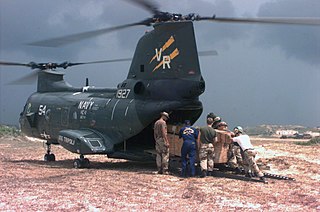
The Unified Task Force (UNITAF) was a United States-led, United Nations-sanctioned multinational force which operated in Somalia from 5 December 1992 until 4 May 1993. A United States initiative, UNITAF was charged with carrying out United Nations Security Council Resolution 794 to create a protected environment for conducting humanitarian operations in the southern half of the country.

United Nations Operation in Somalia I was the first part of a United Nations (UN) sponsored effort to provide, facilitate, and secure humanitarian relief in Somalia, as well as to monitor the first UN-brokered ceasefire of the Somali Civil War conflict in the early 1990s.

The Islamic Courts Union was a legal and political organization founded by Mogadishu-based Sharia courts during the early 2000s to combat the lawlessness stemming from the Somali Civil War. By mid-to-late 2006, the Islamic Courts had expanded their influence to become the de facto government in most of southern and central Somalia, succeeding in creating the first semblance of a state since 1991.

Abdi Hasan Awale or Abdi Qeybdiid is a Somali politician.

United Nations Security Council resolution 837, adopted unanimously on 6 June 1993, after reaffirming resolutions 733 (1992), 746 (1992), 751 (1992), 767 (1992), 775 (1992), 794 (1992) and 814 (1993), the Council condemned the attacks on the United Nations Operation in Somalia II in which 24 Pakistani troops were killed and 56 injured, including 1 Italian and 3 American soldiers.
The Somali National Alliance was a major politico-military faction formed on 16 June 1992 by four different rebel groups that had been in opposition to the regime of former Somali President Mohamed Siad Barre. The SNA was the first major inter-clan and inter-factional political alliance and was considered to be among the most powerful factions of the Somali Civil War. The alliance would most notably face off against the second phase of the United Nations Operation in Somalia in the latter half of 1993.

Thomas M. Montgomery is an American soldier who retired from the United States Army in 1997 at the rank of Lieutenant General. A native of Indiana and graduate of Indiana University, he entered military service in 1963 and commanded an armored company during the Vietnam War, during which he was decorated with the Silver Star for gallantry in the face of the enemy. During the Somali Civil War, he served as deputy commander of the military element of UNOSOM II and would later spend three years as U.S. representative to the NATO Military Committee.
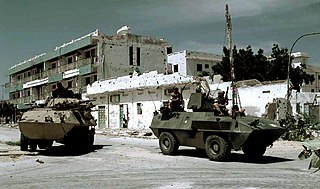
United Nations Security Council resolution 775, adopted unanimously on 28 August 1992, after reaffirming resolutions 733 (1992), 746 (1992), 751 (1992) and 767 (1992) considering a report by the Secretary-General Boutros Boutros-Ghali on the ongoing civil war in Somalia, the Council decided to increase the strength of the United Nations Operation in Somalia I by an additional 3,000 personnel.

The Bloody Monday raid, also known as the Abdi House raid or Operation Michigan, was a US military operation that took place in Mogadishu on 12 July 1993, during the United Nations Operation in Somalia II phase of the UN intervention in the Somali Civil War. Carried out by American QRF troops on behalf of UNOSOM II, the raid was the war's deadliest incident in Mogadishu to that point and a turning point in the UN operation. It inflamed anti-UN and anti-American sentiments among Somalis, galvanizing the insurgency that the US military faced during the Battle of Mogadishu three months later.
The June 5th 1993 attack on the Pakistani military was a major confrontation that occurred concurrently in different parts of the Somali capital of Mogadishu, between Somali citizens & militias against the Pakistani peacekeeping contingent of UNOSOM II.

The 1992 famine in Somalia resulted from a severe drought and devastation caused by warring factions in southern Somalia, primarily the Somali National Front, in the fertile inter-riverine breadbasket between the Jubba and Shebelle rivers. The resulting famine primarily affected residents living in the riverine area, predominantly in Bay Region, and those internally displaced by the civil war.
On 13 June 1993, an element of the Pakistani contingent of UNOSOM II opened fire with a machine gun onto a crowd of protestors in Mogadishu, Somalia, shooting approximately 70 Somalis. At least 20 people were killed in the attack, including women and children, and more than 50 others were wounded. The shooting took place in the aftermath of the 5 June 1993 attack on the Pakistanis a week prior.